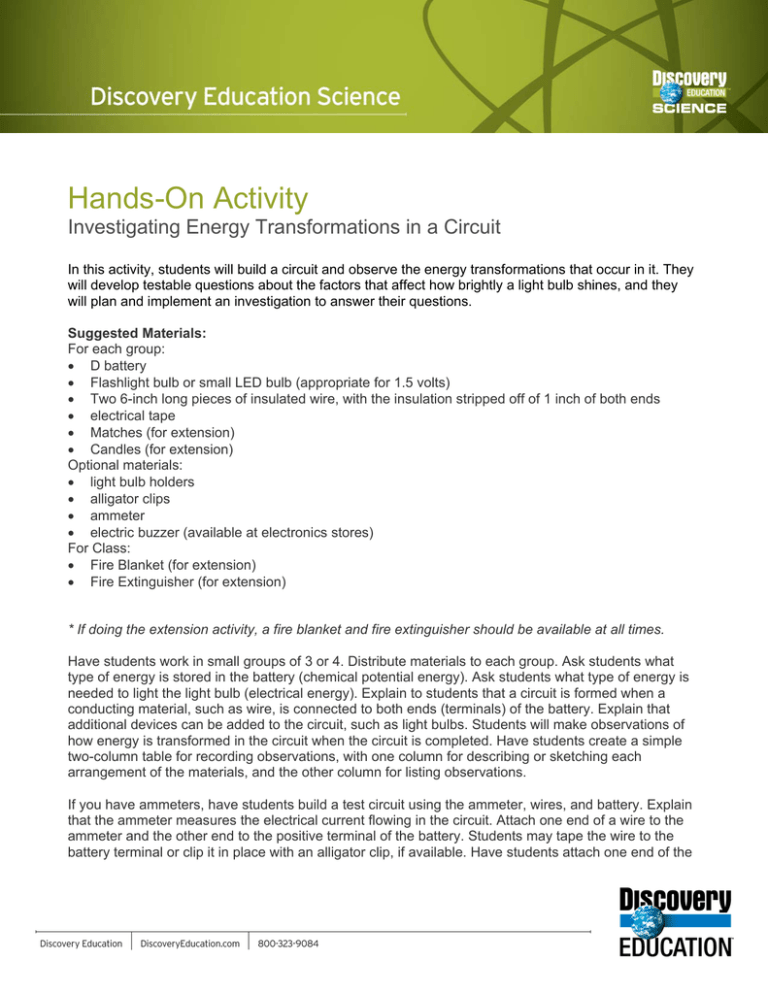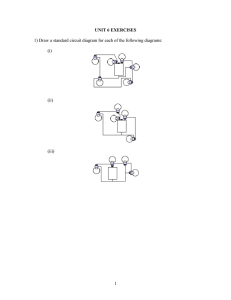Relationship Between Force
advertisement

Hands-On Activity Investigating Energy Transformations in a Circuit In this activity, students will build a circuit and observe the energy transformations that occur in it. They will develop testable questions about the factors that affect how brightly a light bulb shines, and they will plan and implement an investigation to answer their questions. Suggested Materials: For each group: D battery Flashlight bulb or small LED bulb (appropriate for 1.5 volts) Two 6-inch long pieces of insulated wire, with the insulation stripped off of 1 inch of both ends electrical tape Matches (for extension) Candles (for extension) Optional materials: light bulb holders alligator clips ammeter electric buzzer (available at electronics stores) For Class: Fire Blanket (for extension) Fire Extinguisher (for extension) * If doing the extension activity, a fire blanket and fire extinguisher should be available at all times. Have students work in small groups of 3 or 4. Distribute materials to each group. Ask students what type of energy is stored in the battery (chemical potential energy). Ask students what type of energy is needed to light the light bulb (electrical energy). Explain to students that a circuit is formed when a conducting material, such as wire, is connected to both ends (terminals) of the battery. Explain that additional devices can be added to the circuit, such as light bulbs. Students will make observations of how energy is transformed in the circuit when the circuit is completed. Have students create a simple two-column table for recording observations, with one column for describing or sketching each arrangement of the materials, and the other column for listing observations. If you have ammeters, have students build a test circuit using the ammeter, wires, and battery. Explain that the ammeter measures the electrical current flowing in the circuit. Attach one end of a wire to the ammeter and the other end to the positive terminal of the battery. Students may tape the wire to the battery terminal or clip it in place with an alligator clip, if available. Have students attach one end of the other wire to the ammeter and record observations. Then have students attach the other end of the wire to the negative terminal of the battery and record their observations. Have students create a circuit with the light bulb. If bulb holders are available, have students place the bulb in the bulb holder, and then insert one end of a wire into to the bulb holder, and connect the other end to the positive terminal of the battery with tape or an alligator clip. If you do not have bulb holders, have students use tape to connect the wire to the bulb. Have students attach one end of the second wire to the bulb or bulb holder and record observations. Then have students attach the other end of the second wire to the negative terminal of the battery and record their observations. Encourage students to touch the bulb after it has been lit for a couple of minutes and add to their observations. Next, ask students to think about the factors that might influence how brightly the light bulb shines. Students should brainstorm and write down these factors (also known as independent variables). For example, students may wonder if the pressure between the wire ends and the battery terminals affects the brightness of the bulb. They might also consider the effect of adding a second battery or second light bulb to the circuit. Once students have listed these variables, allow each group to choose one to investigate. Have them formulate a testable question, develop a hypothesis, make a plan to test their hypothesis, and prepare an appropriate data table for recording results. Remind students that in a welldesigned investigation, only one factor should be varied at a time, while other factors are held constant. Check each group’s plan before allowing them to proceed with their investigation. Optional: Have students remove the bulb from the circuit and replace it with the electronic buzzer. Students should first connect one end of one of the wires to the buzzer and the other end to the positive terminal of the battery. Then students should connect one end of the other wire to the buzzer and record observations. Students should touch the buzzer at this point. Finally, have students attach the other end of the wire to the negative terminal of the battery, again touch the buzzer, and record their observations. Have students analyze their results. Ask them to explain all the energy transformations that occur in each circuit. Encourage students to use evidence from their investigation to support their explanations. Extension Have students take the match and light the candle. Students should observe the flame and sketch their observations in their science journal or notebook. After students have observed the flame and melted wax, they should blow out the candles. Have students first create an annotated diagram of the energy transformations that took place as they lighted the candle. Next have students create a Venn Diagram to compare and contrast the energy transformation that they observed in the candle with the energy transformations that they observed in the circuit. Sample Correct Responses to Analysis and Conclusions Questions 1. Describe the energy transformations that occur in a circuit containing a battery, a light bulb, an ammeter, and an electric buzzer. Chemical energy in the battery is transformed into electrical energy in the wires, which is transformed into light energy and thermal energy in the light bulb, into energy of motion in an ammeter with a needle or light energy in an ammeter with a digital display, and into sound energy and thermal energy in the buzzer. 2. When a circuit is modified so that a light bulb shines more brightly, what changes with regard to the energy transformations occurring? When the light bulb shines more brightly, more energy is being transformed from chemical to electrical to light energy. 3. Based on the results of your investigation, what characteristics of a circuit do you think are needed to make a light bulb shine brightly? Responses will depend on student investigations and may include: wires securely attached to both battery and bulb; only one bulb in the circuit; fresh battery; multiple batteries or a high-voltage battery. In this activity, students will demonstrate the following Inquiry Skills: Gather Data o Uses the appropriate format to record data: Graph or chart o Uses senses to observe: Seeing (color, shape, size, texture, motion Identify Questions: o Recognize and develop testable questions that: require the changing of one variable at a time. can be answered with a science investigation or observational study. Interventional Study - adjusts one or more elements and observes resulting changes over time. Interpret Data o Identifies and interprets patterns Based on an analysis of data collected during an investigation

